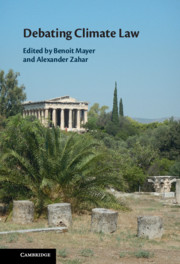Book contents
- Debating Climate Law
- Debating Climate Law
- Copyright page
- Contents
- Contributors
- Acknowledgements
- Abbreviations
- Introduction
- Debate 1: Customary Law
- ~ A ~ The No-Harm Principle as the Foundation of International Climate Law
- ~ B ~ The Significant Transboundary Harm Prevention Rule and Climate Change: One-Size-Fits-All or One-Size-Fits-None?
- Debate 2: The ILC’s Role
- Debate 3: CBDR Principle
- Debate 4: Compliance
- Debate 5: Climate Litigation
- Debate 6: Human Rights
- Debate 7: Historical Responsibility
- Debate 8: Climate Migration
- Debate 9: Negative-Emission Technologies
- Debate 10: Solar Radiation Management
- Debate 11: Climate Assessment
- Reflection 1: Adaptation
- Reflection 2: Loss and Damage
- Reflection 3: Disappearing States
- Reflection 4: Climate Finance
- Reflection 5: Non-State Actors
- Reflection 6: Regime Inconsistency
- Reflection 7: Aesthetics
- Conclusion
- Index
~ B ~ - The Significant Transboundary Harm Prevention Rule and Climate Change: One-Size-Fits-All or One-Size-Fits-None?
from Debate 1: Customary Law
Published online by Cambridge University Press: 15 June 2021
- Debating Climate Law
- Debating Climate Law
- Copyright page
- Contents
- Contributors
- Acknowledgements
- Abbreviations
- Introduction
- Debate 1: Customary Law
- ~ A ~ The No-Harm Principle as the Foundation of International Climate Law
- ~ B ~ The Significant Transboundary Harm Prevention Rule and Climate Change: One-Size-Fits-All or One-Size-Fits-None?
- Debate 2: The ILC’s Role
- Debate 3: CBDR Principle
- Debate 4: Compliance
- Debate 5: Climate Litigation
- Debate 6: Human Rights
- Debate 7: Historical Responsibility
- Debate 8: Climate Migration
- Debate 9: Negative-Emission Technologies
- Debate 10: Solar Radiation Management
- Debate 11: Climate Assessment
- Reflection 1: Adaptation
- Reflection 2: Loss and Damage
- Reflection 3: Disappearing States
- Reflection 4: Climate Finance
- Reflection 5: Non-State Actors
- Reflection 6: Regime Inconsistency
- Reflection 7: Aesthetics
- Conclusion
- Index
Summary
This chapter debates the relevance of customary law to climate law. In climate-law discussions, most attention focuses on the treaties (the UNFCCC, Kyoto Protocol, and Paris Agreement) rather than on custom. Views differ as to the relevance or applicability of customary international law to state responsibility for responding to climate change. Sandrine Maljean-Dubois makes the case that norms of customary international law can meaningfully be applied to climate change mitigation, Christopher Campbell-Duruflé, by contrast, argues that those norms are too vague to address the problem in any meaningful way. This debate has important implications for determining the level of mitigation ambition that states must implement.
Keywords
- Type
- Chapter
- Information
- Debating Climate Law , pp. 29 - 39Publisher: Cambridge University PressPrint publication year: 2021

